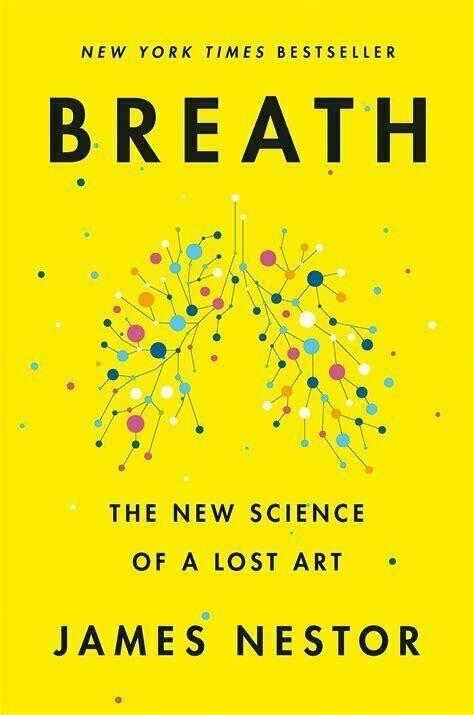Breathing is even more crucial than you think
Never really thought a subject like breathing could be so fascinating. We do it all the time and mostly without thinking, but in reality there is so much to it. Both when we do it correctly as well as when do it incorrectly. If you are remotely interested in the subject, I highly recommend the following book. I for one am intend on applying many of the learnings and have in fact seen a drop in my blood pressure just by focussing on nasal breathing (don’t know whether the drop will last, but I have never seen these levels since I starting measuring it some 6 months ago).
The book I have read is Breath: the new science of a lost art by James Nestor.

And before you decide whether it is worth reading, please find below my 13 main take-aways. Surely some of it is interesting for you.
- Billions of years ago, the atmosphere on earth was filled with carbon dioxide. Early life forms used carbon dioxide as an energy source and oxygen was the waste product. Little by little the level of oxygen increased.
- Oxygen produces 16 times more energy than carbon dioxide.
- Newer life forms used Oxygen as their energy source and could become more complex beings, because of the increased energy obtained from it.
- Humans also use Oxygen as their main energy source and it is inhaled and then absorbed in the cells of our body through our longs and blood stream.
- Humans have become worse breathers throughout their history due to the changes in diet “thanks to” the advances in cooking.
- Cooked food releases more easily energy, which has allowed us to have a larger brains, which left less space for sinuses, mouths and airways
- And more importantly, cooked food is softer. Less chewing led to changes in our facial structure, which in turn also reduced space for airways.
- In order to improve our breathing, firstly we need to breath “exclusively” through the nose:
- It increases nitric oxide sixfold. Nitric oxide plays an essential role in blood circulation and delivering oxygen to the cells.
- When breathing through the nose, the body can regulate which nostril is used more for breathing, which in turn influences the 2 parts of the autonomous nervous system: right for sympathetic nervous system and left for parasympathetic nervous system.
- If necessary, apply sleep tape at night.
- Lung capacity is one of the best indicators of expected life span. A typical adult only engages as little as 10 percent of the range of the diaphragm when breathing. Focus on fully exhaling to extend this range, at least during some time of the day.
- The best way to prevent many chronic health problems, improve athletic performance, and extend longevity is to focus on how we breathe, specifically to balance oxygen and carbon dioxide levels in the body. To do this, we’d need to learn how to inhale and exhale slowly.
- Cells will absorb oxygen from the blood stream and release carbon dioxide. In fact, the amount of oxygen absorbed by a cell is determined by the amount of carbon dioxide in the cell. As a result, even when breathing more quickly then necessary, we don’t absorb more oxygen. However, the frequency of breathing does influence the level of carbon dioxide in our cells and blood stream (and exhaled breath), which is critical for other aspects such as pH level of the blood, blood vessel dialation.
- There is a benefit to breathing slower and less and keeping carbon dioxide levels up (in the cells), so that oxygen absorption is optimum. The optimum amount of air we should take in at rest per minute is 5.5 liters and the optimum breathing rate is about 5.5 breaths per minute.
- One of the culprits of our poorer breathing was food and eating, well, the first step to improving airway obstruction isn’t orthodontics but instead involves maintaining correct “oral posture”. It just meant holding the lips together, teeth lightly touching, with your tongue on the roof of the mouth. Hold the head up perpendicular to the body and don’t kink the neck.
- Furthermore, we need to chew more. The more we gnaw, the more stem cells release, the more bone density and growth we’ll trigger, the younger we’ll look and the better we’ll breathe. Tools like the Homeoblock can help with this, if necessary.
- The author argues that there are illnesses and afflictions that are not easily solved by our current healthcare system: tingling fingers, chronic diarrhea, rapid heart rate, diabetes, autoimune disease, erectile disfunction. He argues that what they often suffer is from communication problems along the vagal and autonomic network, brought on by chronic stress. Fixing the autonomic nervous system can effectively cure or lessen these symptoms.
- Breathing allows us to intake oxygen, our source of energy. However, breathing is also a power switch to this autonomic nervous system: Willing ourselves to breathe slowly will open up communication along the vagal network and relax us into a parasympathetic state. Breathing really fast and heavy on purpose flips the vagal response the other way, shoving us into a stressed state.
- Techniques for getting into both states are useful for this. It is the flip-flopping that is possibly key to obtaining the benefits. One of the techniques mentioned frequently regarding entering the stressed state is Tummo (inner fire medition). Check out Wim Hof on YouTube if interested.